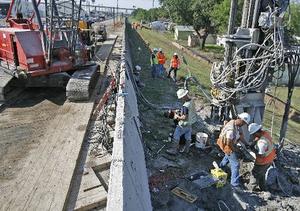Flood defenseNew Orleans flood defense system nears completion
The Army Corps of Engineers is rapidly nearing the completion of its upgrades to the massive levee and flood defense system designed to protect the greater New Orleans area from another Hurricane Katrina

Workers reinforcing subsurface levee support // Source: nola.com
The Army Corps of Engineers is rapidly nearing the completion of its upgrades to the massive levee and flood defense system designed to protect the greater New Orleans area from another Hurricane Katrina.
Late last year the Corps estimated that the $14.6 billion project was more than 97 percent complete and expected to finish the project by the end of June 2012.
The new 133-mile flood defense system that now rings the New Orleans area has been a massive endeavor setting many records for the Corps, the United States, and the world.
For instance the 1.8-mile canal surge barrier along Lake Borgne is the largest design-build project in the history of the Army Corps of Engineers, while the barrier itself is the largest of its kind in the world with a wall twenty-eight feet above the water line and three gated structures.
In addition, the project’s West Closure Complex features the world’s largest drainage pump station in the world and the largest sector gate in the United States.
“The system doesn’t resemble what was here before Hurricane Katrina in terms of the level or risk reduction provided,” said Michael F. Park, the head of Task Force Hope in Louisiana, part of the Corps of Engineers’ Mississippi Valley Division.
According to Park a significant amount of research went into designing the new flood protection system which is aimed at preventing storm surges from overtaking the 133-mile perimeter and pumping out any water that exceeds it.
“The corps did undertake a very thorough hydraulic analysis to determine what would be the potential storm surge at every point around the perimeter,” Park said.
Researchers began by modeling more than 150 storms based on history as well as theory ranging from a twenty-five year event to a 5,000-year event.
“We’ve also factored in the subsidence that we’ve experienced in the southern Louisiana region and also the effects of climate change and sea level rise so that hard features are designed to be valid through 2057,” Park said.
With the new flood defenses, Park is optimistic that the city will now be able to withstand a storm similar to Hurricane Katrina.
“We should fare quite nicely in terms of flood risk reduction,” he said.
